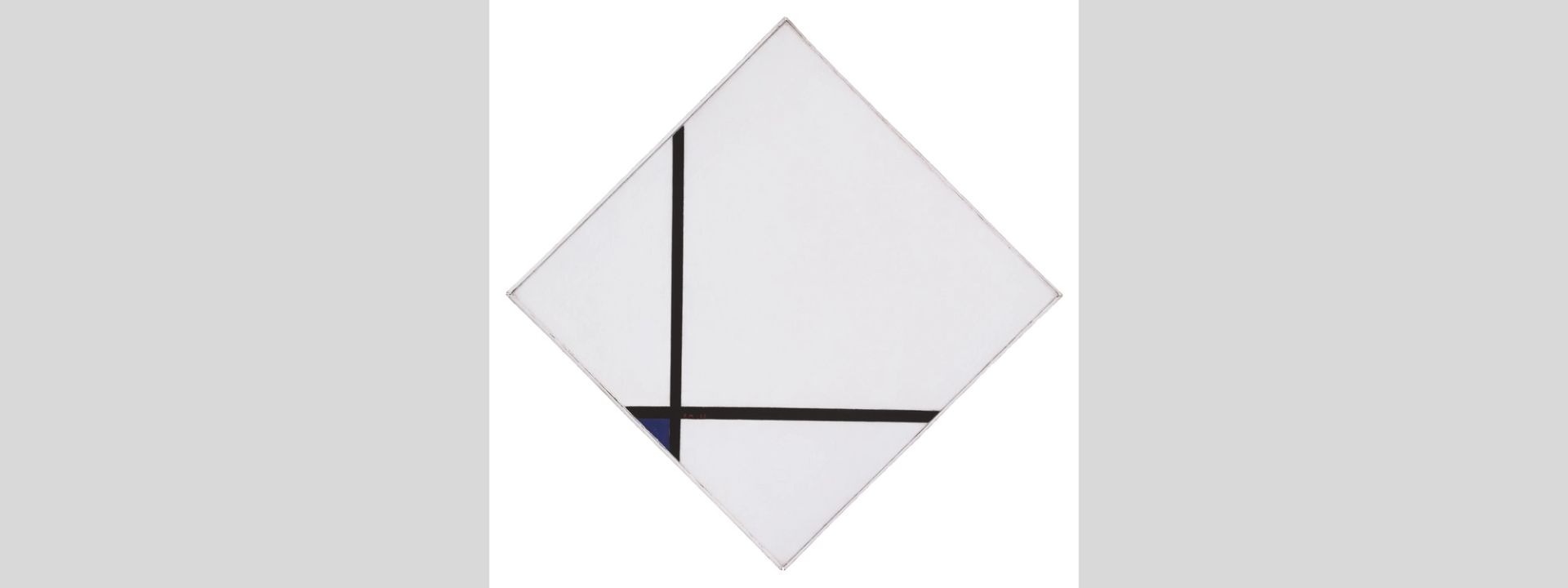In the early 1920s, Piet Mondrian began a friendship with Sophie Küppers (1891–1978), a German citizen living in Hanover and the widow of Paul Küppers (d. 1922), artistic director of the progressive Kestner Society. Küppers, later known as Sophie Küppers-Lissitzky after she married the artist El Lissitzky in 1927, hoped to promote Mondrian’s work in her country and asked him to send paintings on consignment for her to sell in Germany. In 1924 he sent four canvases, which she showed to Alexander Dorner, the director of the Hanover Provinzialmuseum (also known as the Landesmuseum); Dorner purchased one of them for the museum.(1) In 1926, Mondrian painted the unusual diamond-shaped Composition with Blue.
As a major proponent of modern abstract and Expressionist art in Germany Dorner was forced to resign his position as director of the Hanover Provinzialmuseum in 1936. He left Germany and became director of the Rhode Island School of Design Museum in 1938. As Dorner recalled, Mondrian’s Composition with Blue, together with Lissitzky’s Proun 2, once hung in the famous Abstract Gallery (Abstraktes Kabinett) of the Hanover museum. In 1937, as part of its campaign against “degenerate art”, the Nazi government dismantled the Abstract Gallery and confiscated some 270 works from the museum.(2) Although Composition with Blue is known to have been one of those seized, its ownership presented a puzzle. The painting does not appear in the records of the Hanover museum, the 1930 catalog of the museum’s holdings, or in the official list of works owned by museum at the time of the Nazi seizures.(3) Only one Mondrian is listed; this is almost certainly the painting purchased through Küppers in 1924, which was sent to the Nazi-organized "Degenerate Art" exhibition in Munich in 1937 and is now lost.(4) Oddly, Composition with Blue does not appear either on the list of confiscated works on loan to the museum at the time. Again, only one Mondrian is recorded: most likely the 1926 painting entitled Schilderij No. 2, listed in the museum’s 1930 catalog as a loan from the Sophie Küppers collection.(5)
An obvious question presented itself: Could the Philadelphia Museum of Art’s Composition with Blue also have belonged to Sophie Küppers-Lissitzky? She lent thirteen works by various artists from her private collection to the Hanover Provinzialmuseum in 1926 before moving to Russia, all of which were confiscated in 1937 as part of the “degenerate art” campaign. Normally, Nazi officials returned or compensated for privately owned works impounded from museums; Küppers’ collection represents an exception. Most likely she was singled out for punishment not only because she had emigrated to Russia, thereby forfeiting her German citizenship and rights in the eyes of the Reich, but also because she was married to Lissitzky, a prominent supporter of the Soviet Union’s Communist regime and a Jew. The Lissitzkys’ son and heir, Jen Lissitzky, has recently sought the return of several confiscated works from his mother’s collection now housed at other museums (two of which have been returned).(6) The thirteen paintings in question are listed in a document written by Sophie Küppers when the works were entrusted to the Hanover museum.(7) However, only one Mondrian appears on the list, and this is almost certainly the painting Schilderij No. 2, recorded in the museum’s 1930 catalog as her loan. Together with Composition with Blue, this work was confiscated from the museum in 1937 and stored at Schloss Niederschönhausen (see below), where it was registered as number 7034, the number preceding Composition with Blue. Its whereabouts today are unknown.
Since there is no doubt that Composition with Blue was at the Hanover museum in 1937, it must have been present as an unofficial loan. The question is who owned it, if not Sophie Küppers? The likeliest scenario is that Mondrian consigned the painting to Küppers after it was exhibited in Amsterdam in 1926, hoping she could sell it to the Hanover museum for him, as she had done with his earlier painting. Later, before leaving Germany for Russia in 1927, Küppers probably asked Dorner to keep Composition with Blue in storage, still hoping for a chance to sell it to the museum in the future and little anticipating that it would fall victim to a Nazi purge.(8) Therefore, Mondrian himself was probably the owner of the painting at the time of its confiscation.
The "purification" of German museums continued until March 1938. A salesroom was set up in the Schloss Niederschönhausen outside of Berlin, where the most "exploitable" works of art were collected (that is, those with the highest potential resale value on the international art market), totaling 780 paintings and 3,500 works of art on paper.(9) Composition with Blue was sent to Niederschönhausen, as demonstrated by a label on the back of the painting stamped with the number 7035, which corresponds to the "Degenerate Art" confiscation register.(10) From there, the painting made its way to the dealer Karl Buchholz, and then to his associate Curt Valentin (see Lissitzky, Proun 2). Neither Composition with Blue nor Lissitzky’s Proun 2 appeared in the notorious "Entartete Kunst" exhibition of 1937.
The New York collector Albert E. Gallatin purchased the painting, along with Proun 2, from Curt Valentin’s Buchholz Gallery in New York on August 24, 1939. Mondrian was informed of the travels of his painting and apparently approved of its eventual home in the U.S.: in a letter to Ben Nicholson of December 6, 1939, Mondrian noted that "[Gallatin] has bought also one of my two Hannover museum pictures, rejected by Hitler."(11) In late 1940 Mondrian offered to restore his painting at Gallatin’s Museum of Living Art in New York.(12) Composition with Blue was bequeathed by Gallatin to the Philadelphia Museum of Art in 1952.



